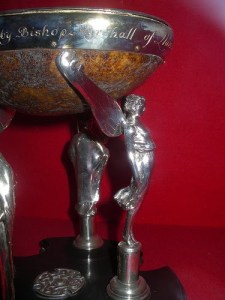The Veneration of water in 12 objects……number four, St. Teilo’s skull

St. Teilo’s Skull from
http://billwaldenjones.blogspot.co.uk/2011/02/new-age-crank.html
This is the 101th post and I’ve picked a famous sacred well association the head cult. Much has been commented on the connection between sacred springs and heads, in particular. The term ‘head cult’ often being applied to a number of wells, but in reality there is little to prove the existence of anything concrete as a cult or continued worship. Such is the most famed site associated with a skull: St. Teilo’s Well or Ffynonn Deilo in the Welsh county of Pembrokeshire, a noted holy man who has given his name to many wells and churches. This well itself is nothing particularly impressive nor archaeologically significant, consisting of shallow square chamber and fills a series of ponds. However, the legend is quite remarkable. Asaph Dar’s Wales and the Welsh notes:
“The faith of some of those who used to visit the well was so great in its efficacy that they were wont to leave it wonderfully improved. An old inhabitant of the district, Stephen Evans used to relate a story to the effect that a carriage drawn by four horses came over to Llandeilo. It was full of invalids from the cockle village of Penclawdd, in the Gower Peninsula, who had determined to try the waters in the well. They returned, however, no better than they came; for though they had drunk of the well they had neglected to do so out of the skull. This was afterwards pointed out to them by somebody and they resolved to make the long journey to the well again. This time, we are told, they did the right thing and departed in excellent health. Such is the great persistence of primitive beliefs that while the walls of the church have long fallen into decay the faith in the well continues in a measure intact.”
Skulls (and heads) have a long and possibly confused association with sacred springs. Yet how did a piece of this saint’s skull end up being separated from the body and be associated with a holy well. Tradition asserts that when Llandaff Cathedral was stormed in the 15th century by Owen Glyndwr, a local man, Sir David Mathew paid for its restoration and was given the skull as a gift by the grateful Bishop. This was then set into a reliquary.
For seven generations, the Mathew family owned this private relic, until it handed over to the Melchoir family who owned Llandeilo farm in the 17th century. By then probably as a result in changing Christian views concerning relics, the skull was stripped of its reliquary, although its then use a drinking cup goes against this view, unless there was a period when the relic was disregarded followed by a period when the family either realised a possible income source or became more ‘Catholic’. Whatever, this is how the skull became associated with a holy well for own the farm as the name suggests is a site associated with the saint.
The Melchoir family, where the water would be lifted from the well using the skull and according to Sir John Rhys, quoted in Bailey (2003) that it had to be an heir of Llandeilo. Jones (1955) in his Holy Wells of Wales notes that a man in 1906 stated that a boy and two other lads were cured of an illness by drinking out of the skull early in the morning and that he reported that the waters were botted by the family.
However, the use of the skull to drink from would have stopped around….when the skull disappeared only to be returned by the last of the family to Llandaff Cathedral in 1993 where it now remains. The search for the skull makes an interesting read, especially the lack of publicity wanted for it by its ‘owners’ and can be read in Bailey’s excellent volume.
What is interesting is that the cult of head worship should develop so late in this story. This suggests perhaps the widespread survival of such beliefs into the 1600s, unless there was a local well already using the skull independently? Much has been said about the possibility of the Melchoir families being some sort of well guardians preserving a cult, although this is unlikely and more wishful thinking by new age antiquarians. More likely is that the family identified the coinage in developing the ‘worship’. An interesting postscript is for an examination of the skull in the Office of Works volume on ancient and historical buildings in Pembrokeshire records of the skull:
“the cranium is very old, and is polished from constant handling. A part of one superciliary ridge remains, and this is of such slight elevation as to make it almost certain that this skull is that of a female, while the open sutures point to the same conclusion.”
Well there you go! Clearly, the combination of faith and the water worked more directly than anything is ‘relic’ could add if this analysis was indeed correct. Yet whatever the facts the use of a skull in such activities is an interesting form of water veneration.
I’ve posted this on the 8th as the first posts were on the 8th October.
Posted on April 8, 2014, in Folklore, Saints, Wales and tagged antiquarian, archeology, calendar customs, Catholics, Celtic, Ceremonies, earth mysteries, folklore, head cult, healing wells, Holy well blog, Holy wells blog, Local history, st teilo's, Wales. Bookmark the permalink. 1 Comment.
Interestinng thoughts